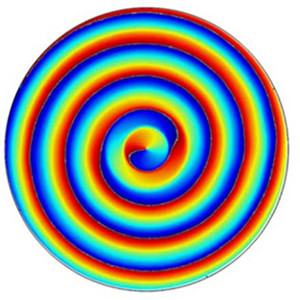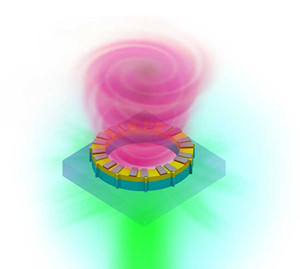
Vortex Laser May Help Shape the Future of Data Transfer
source:Photonics.com
keywords: Vortex Laser Data Transfer
Time:2016-09-08
A light-based communications tool that is structured to carry data in a helical path may enable fast transfer of large amounts of data, resolving potential bottlenecks in data transfer as the demand for information sharing grows. The novel technique uses a vortex beam that travels in a corkscrew pattern, encoding data into the vortex twists. The shape of the beam enables it to encode data for optical communications with greater freedom than a conventional laser, giving it the potential to carry ten times or more information than lasers that move in a linear direction.

A close-up look at the vortex laser beam. Courtesy of the University at Buffalo.
Although the size of today’s computers has been scaled down as increasing capability is packed into silicon chips, creating light beams with the desired amount of twist has typically been achieved with bulk optic devices.
A possible approach would be to use a twisted-light source with a controlled amount of optical angular momentum that would be generated internally to the designed device structure.
To make a vortex laser useful for practical applications, researchers at the University at Buffalo reduced a vortex laser to a size compatible with the computer chips used in today’s computers. They used orbital angular momentum (OAM) to distribute the laser in a corkscrew pattern, and demonstrated that a microring laser could produce a single-mode OAM vortex lasing with the ability to precisely define the topological charge of the OAM mode.

A vortex laser on a chip. Because the laser beam travels in a corkscrew pattern, encoding information into different vortex twists, it's able to carry ten times or more the amount of information than that of conventional lasers. Courtesy of the University at Buffalo.
The research team also showed that the polarization associated with OAM lasing could be further manipulated on demand to create a radially polarized vortex emission.
"To transfer more data while using less energy, we need to rethink what's inside these machines," said professor Liang Feng.
Use of OAM lasing, especially at a micro- and nanoscale, could address the growing demand for information capacity. The research team’s OAM microlaser could find applications in the next generation of integrated optoelectronic devices for optical communications in both quantum and classical regimes. As techniques like wavelength-division multiplexing and time-division multiplexing near their data transfer limits, microlasers could find application in telecommunication and information technologies to increase the rate of information transmission.
The research was published in Science (doi: 10.1126/science.aaf8533).
MOST READ
- RoboSense is to Produce the First Chinese Multi-beam LiDAR
- China is to Accelerate the Development of Laser Hardening Application
- Han’s Laser Buys Canadian Fiber Specialist CorActive
- SPI Lasers continues it expansion in China, appointing a dedicated Sales Director
- Laser Coating Removal Robot for Aircraft
PRODUCTS
 FISBA exhibits Customized Solutions for Minimally Invasive Medical Endoscopic Devices at COMPAMED in
FISBA exhibits Customized Solutions for Minimally Invasive Medical Endoscopic Devices at COMPAMED in New Active Alignment System for the Coupling of Photonic Structures to Fiber Arrays
New Active Alignment System for the Coupling of Photonic Structures to Fiber Arrays A new industrial compression module by Amplitude
A new industrial compression module by Amplitude Menhir Photonics Introduces the MENHIR-1550 The Industry's First Turnkey Femtosecond Laser of
Menhir Photonics Introduces the MENHIR-1550 The Industry's First Turnkey Femtosecond Laser of Shenzhen DNE Laser introduced new generation D-FAST cutting machine (12000 W)
more>>
Shenzhen DNE Laser introduced new generation D-FAST cutting machine (12000 W)
more>>
